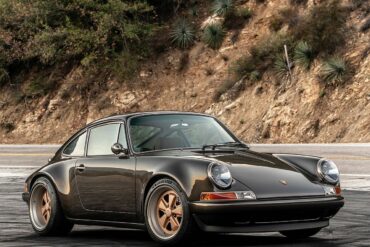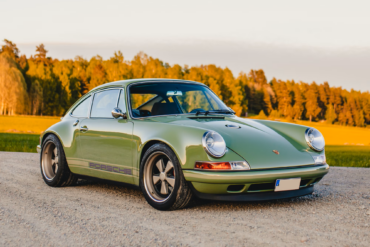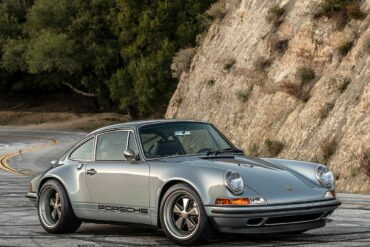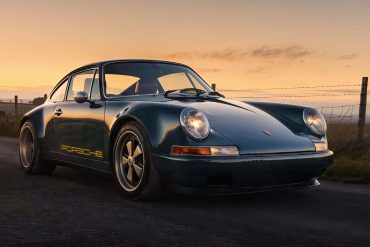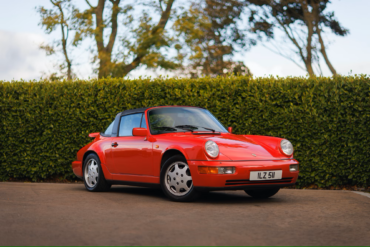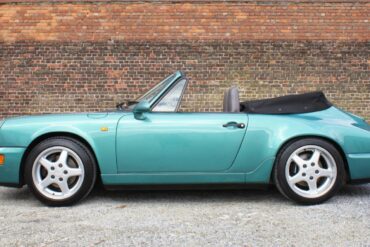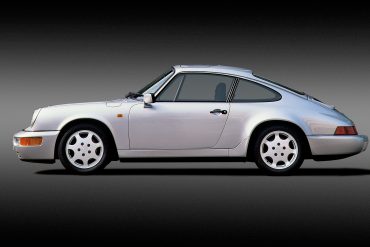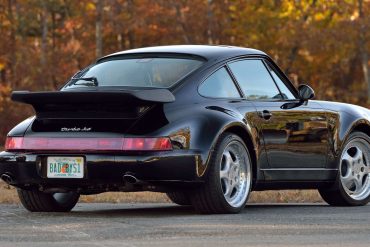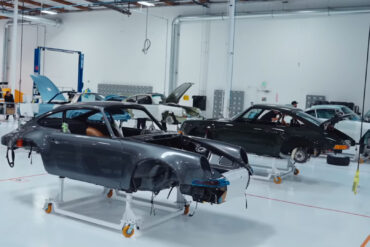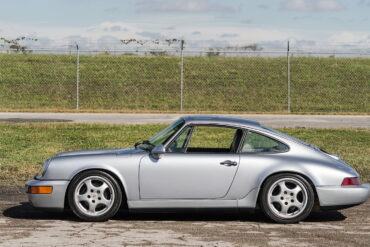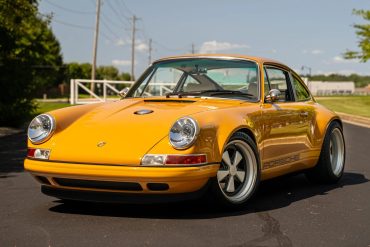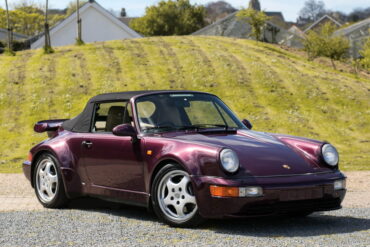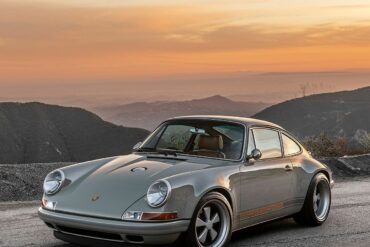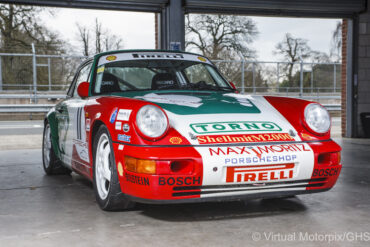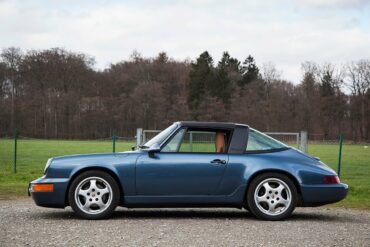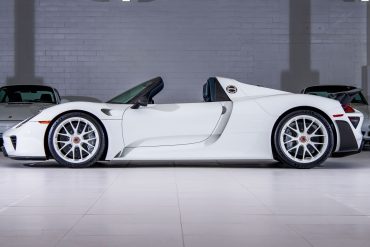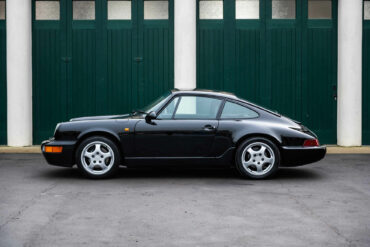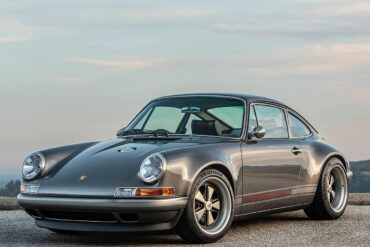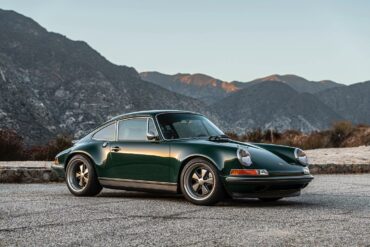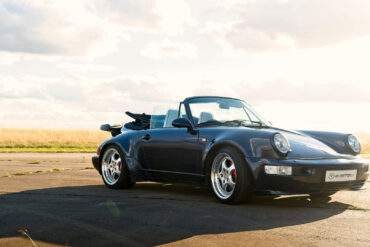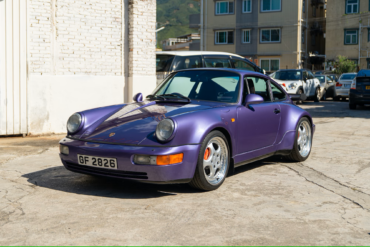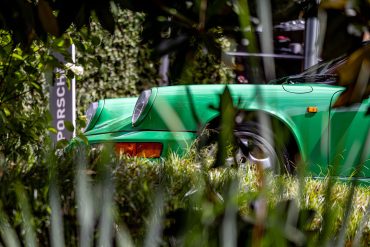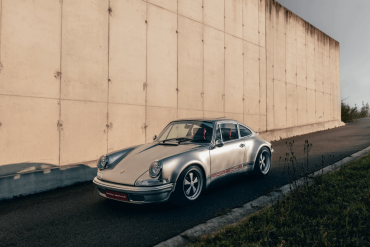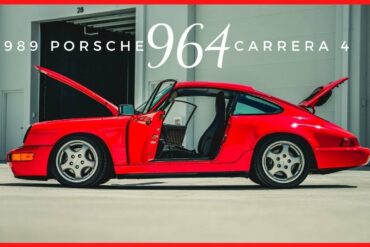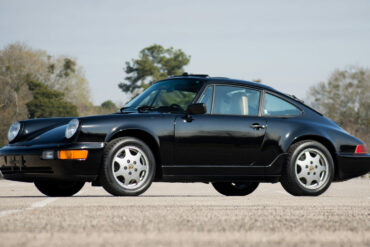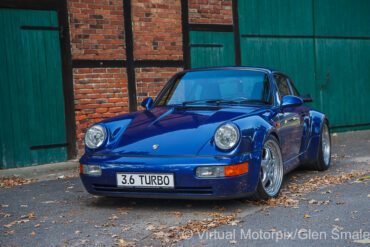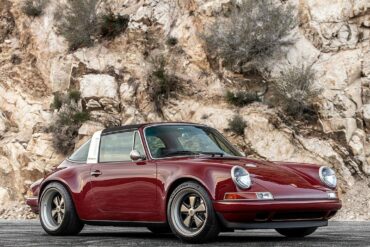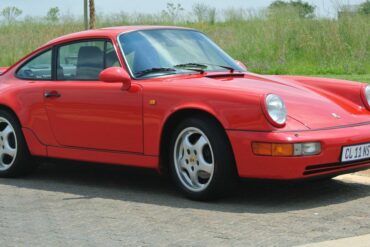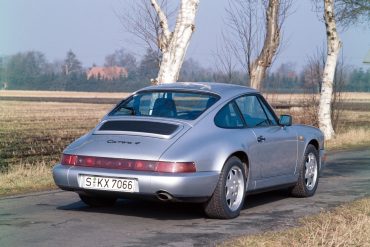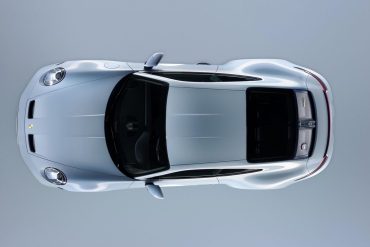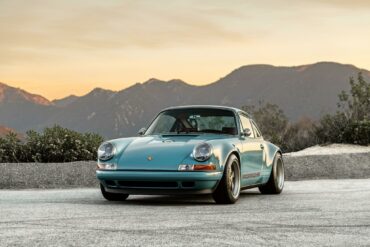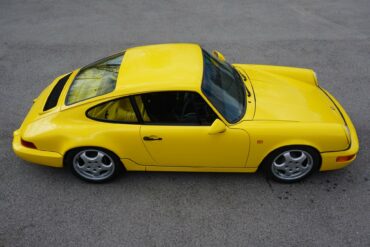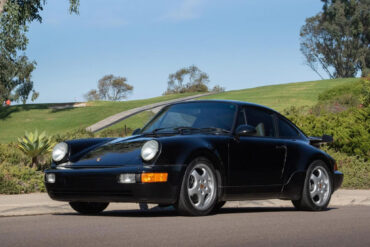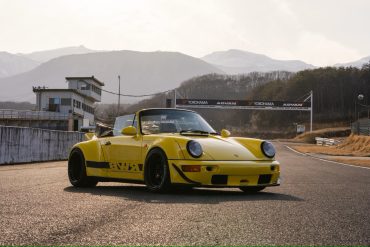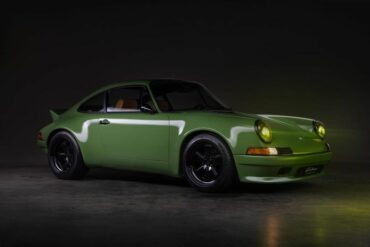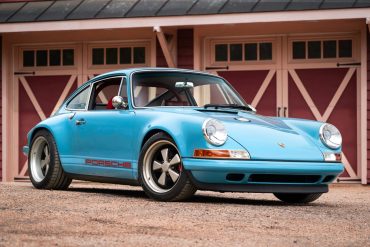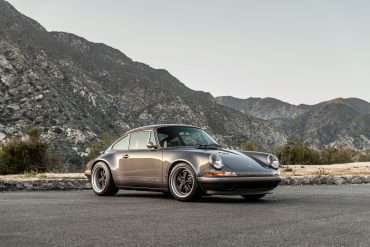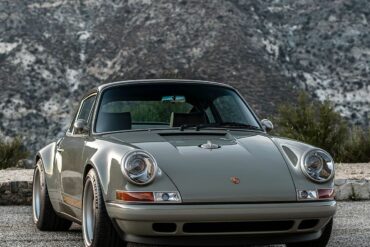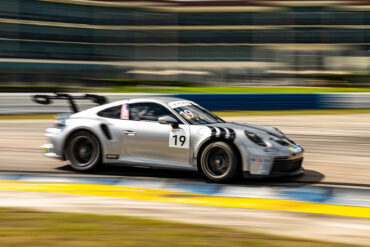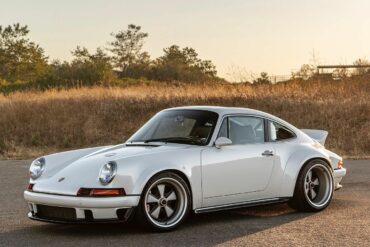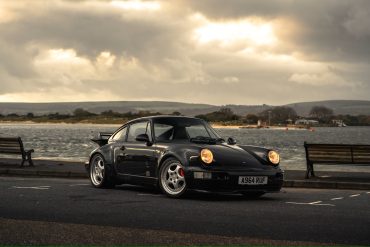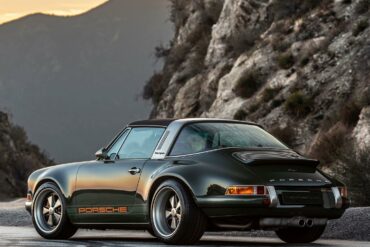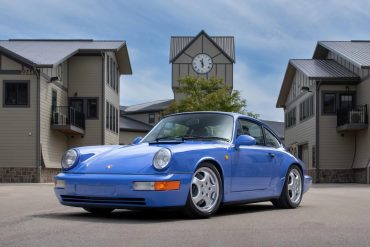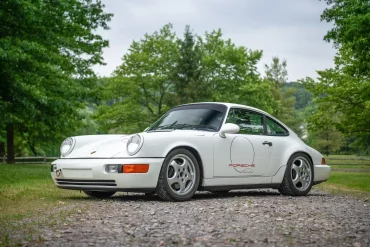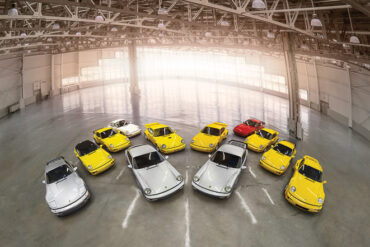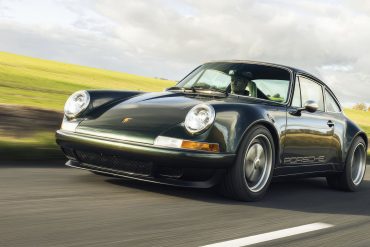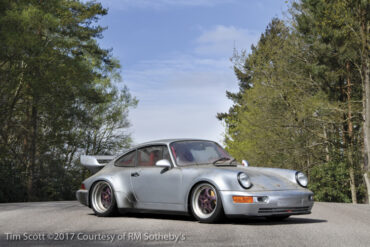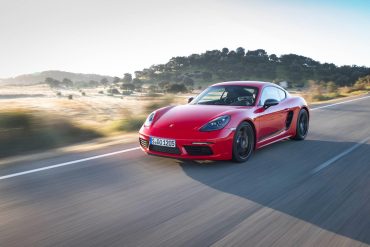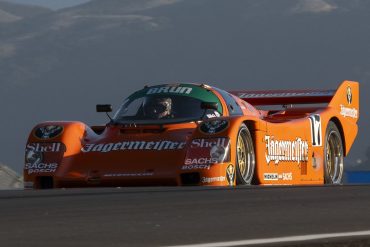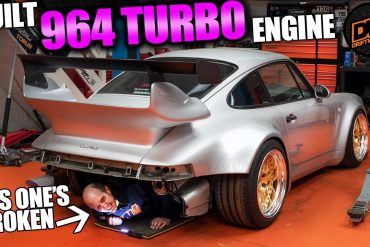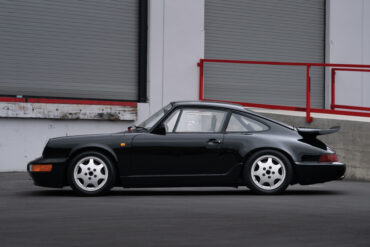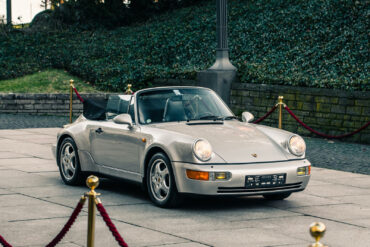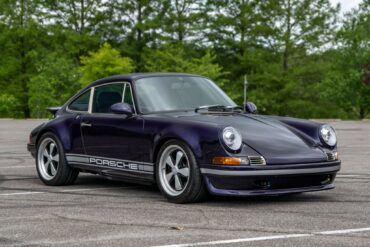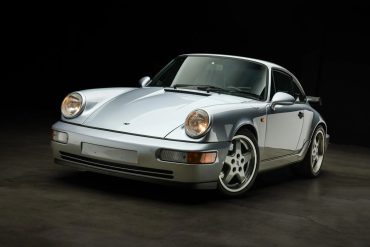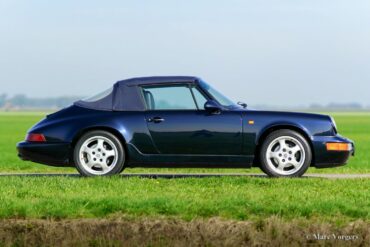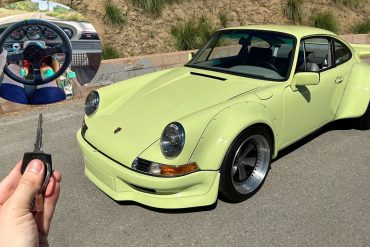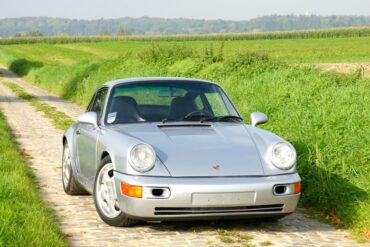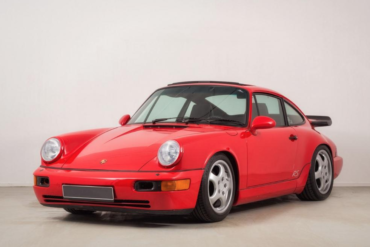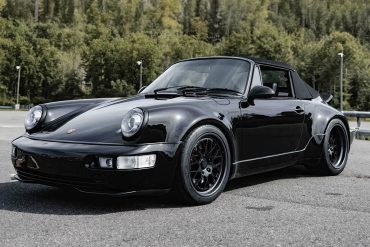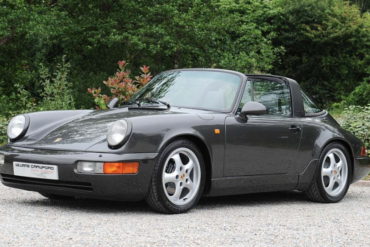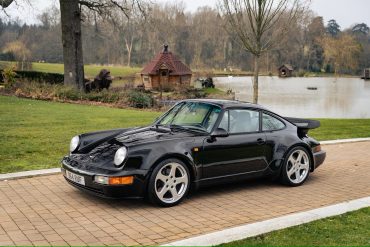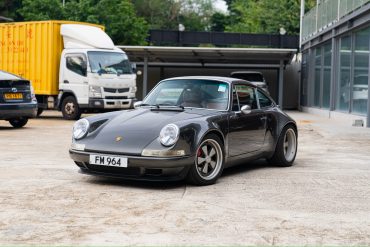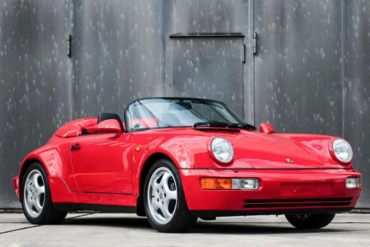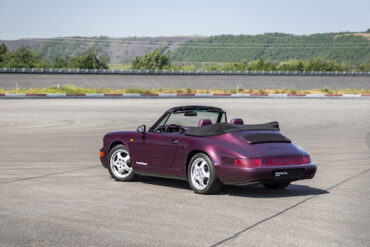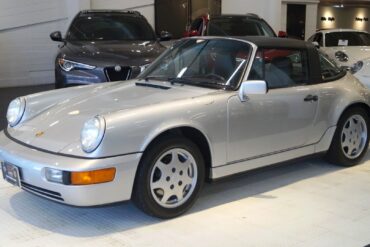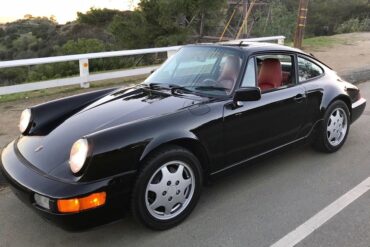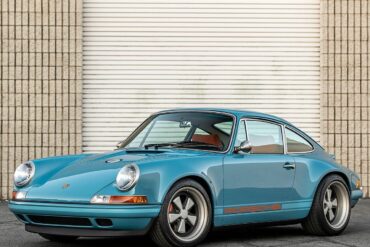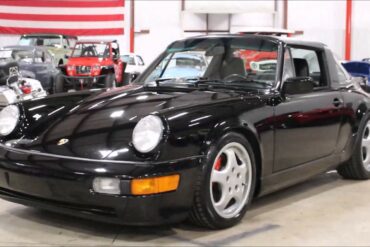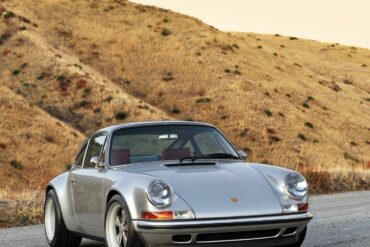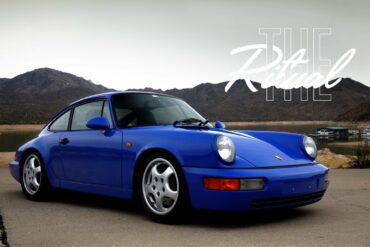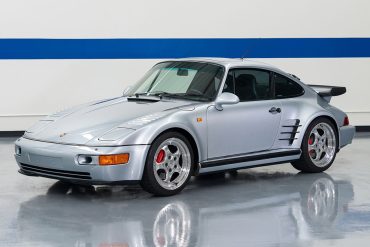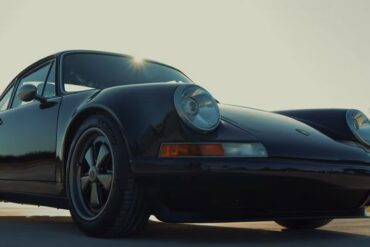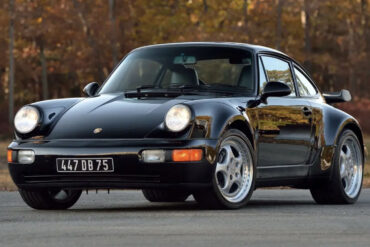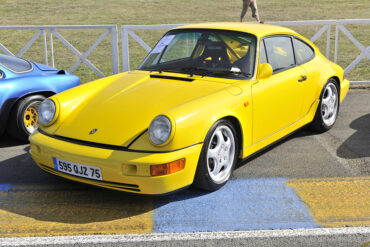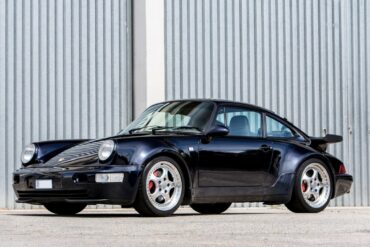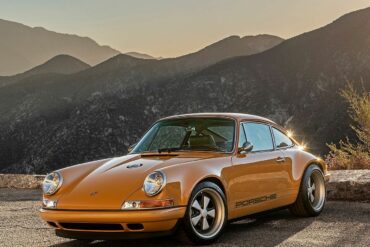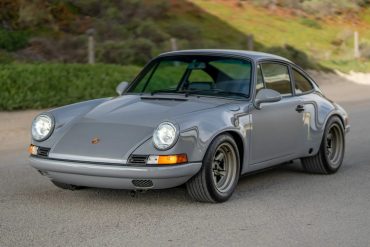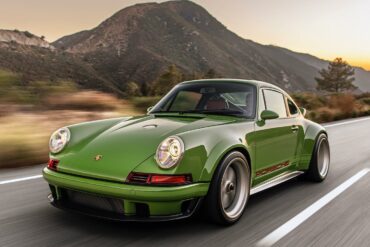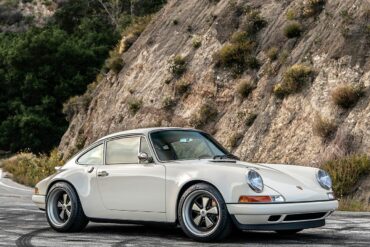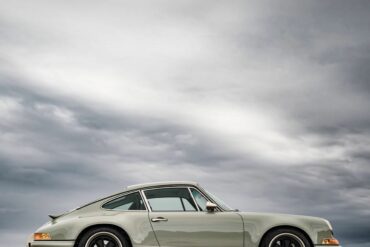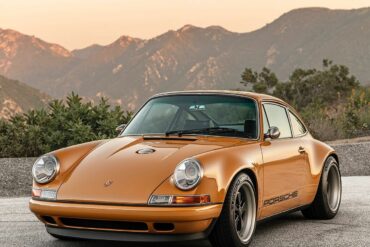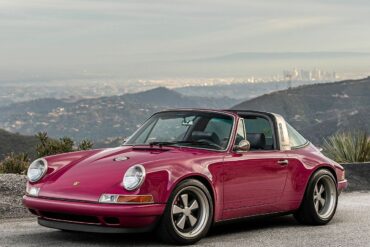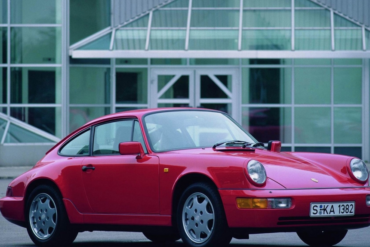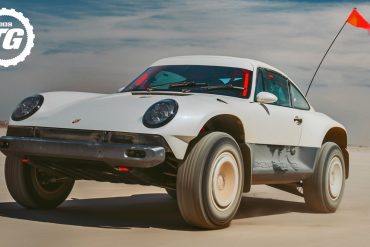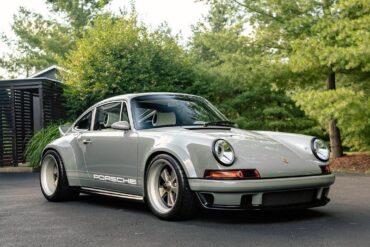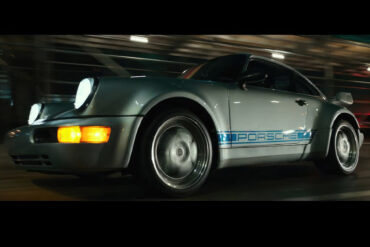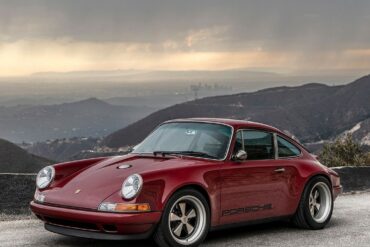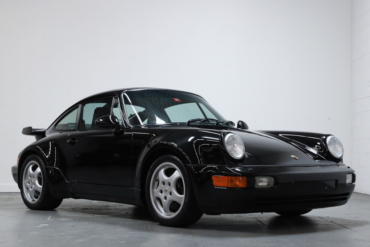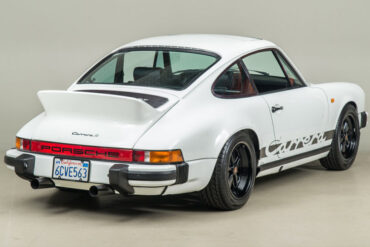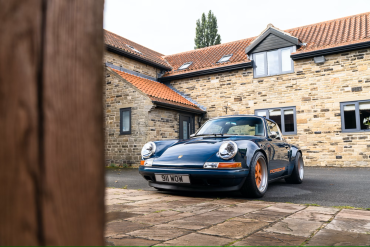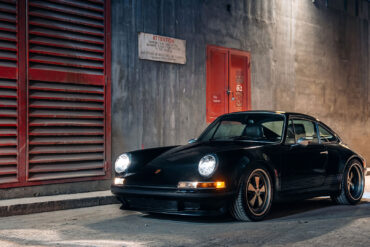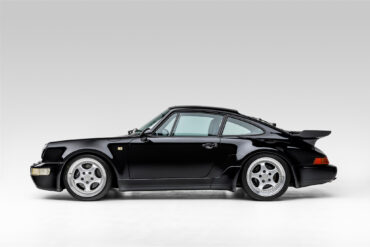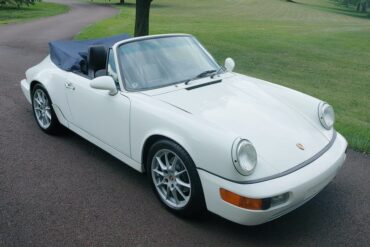The “Indy Commission” by Singer Vehicle Design was built for IndyCar legend Dario Franchitti. Powering the Indy commission is a...
Porsche 911 (964)
In 1989 Porsche came out with the 911 Carrera 4 (964). The new 911 was a contemporary take on the classic two-door sports car and came at a time when many were predicting the end of the 911 (the company was producing the 944 and working on the upcoming 968). The long run of the previous 911 meant the 964 needed a major update and Porsche delivered on that promise with 85% new components and virtually none of the predecessor’s architecture used. Save for the introduction of aerodynamic polyurethane bumpers and an automatically-extending rear spoiler which replaced the “whale tail” found on the 911 throughout the 1980’s, externally, the 964 kept the same style as the classic 911. The 964 rode on a completely redesigned chassis with rear suspension switching from torsion bar to trailing arms with Porsche’s “Weissach” rear axle, which added self-steering elements to reduce the chance of oversteer. It featured a naturally aspirated 3.6 liter boxer engine that produced an impressive 250 horsepower. See all of our Porsche 964 Research.
Coffee run in a very special 964 RS that just so happens to be chassis number 1 ...
Singer Vehicle Design has established itself as one of the premier names in the world of custom Porsche 911s. The...
Singer Vehicle Design – Charlottesville Commission Today, we take a closer look at the Singer Vehicle Designs Charlottesville Commission. At the...
The esteemed UK firm, Theon Design, known for their custom reconfigurations of the iconic Porsche 911, has recently unveiled a...
Collecting Cars is auctioning a stunning example of the 964-generation Porsche 911 Carrera 2 Targa. This particular example is offered...
1993 Porsche 911 Carrera 4 Cabriolet (964) Technical Specifications Engine Type Flat 6 Induction Normally-aspirated Cooling Air/oil-cooled Valvetrain Single overhead...
Porsche 911 (964) (1988 – 1994) Story & History Type 964 – The 3rd Generation Porsche 911 Premiere: 1988 September 28...
Porsches are, by nature, expensive cars. Still, it’s hard not to notice when one sells for over a million dollars,...
Singer has come a long way since its founder Rob Dickinson started turning Porsche 964s into four-wheeled jewelry 12 years...
Porsche Option Codes – Porsche 911 (1993 Model Year) Looking to decode your 1993 Porsche 911 option codes? Want to...
Singer is widely recognized as a top name in the world of Porsche 911 tuning and restoration. Each Porsche 911...
Founded in Los Angeles in 2009, Singer is globally renowned for bespoke restorations of Porsche 911 sports cars. Based on...
The Turbo-look Porsche 964 has always been a very desirable automobile, among them 1,532 Carrera 2 Cabriolets constructed worldwide. Within that group, there were some cars that were even more specialized. The Register says six Turbo-look cabriolets were pulled off the production line in Zuffenhausen and transported to the Porsche Exclusive shop in Weissach. Three of these six powerful and luxuriously equipped drop-tops were equipped with left-hand drive for buyers in Germany (Code C00), and the other three were fitted with right-hand drive
Singer Vehicle Design – Queenstown Commission Today, we take a closer look at the Singer Vehicle Designs Queenstown Commission. The Queenstown...
Introduced in 1989 (the year of the 911’s 25th anniversary), the 964 Carrera 4 was a significant new model for the company, but the 4-wheel drive system was deemed unsuitable for the company’s racing series. Manufactured alongside the Carrera 4 at the same time was the more traditional rear-wheel drive Carrera 2, but this model’s launch was only planned for a year later, in the hope that it would not detract from potential sales of the Carrera 4. The 1990 season was the first season that saw the 911-based model become the pillar on which the Porsche Carrera Cup series has been established.
1990 Porsche 911 Carrera 4 Targa (964) Technical Specifications Engine Type Flat 6 Induction Normally-aspirated Cooling Air/oil-cooled Valvetrain Single overhead...
As the Porsche market continues its strong trajectory, RM Sotheby’s is thrilled to unveil “The White Collection” auction—a unique gathering...
1992 Porsche 911 Carrera 2 Coupe (964) Technical Specifications Engine Type Flat 6 Induction Normally-aspirated Cooling Air/oil-cooled Valvetrain Single overhead...
Singer Vehicle Design – Kent Commission Today, we take a closer look at the Singer Vehicle Designs Kent Commission. The...
Singer Vehicle Design – Lauf Commission Today, we take a closer look at the Singer Vehicle Designs Lauf Commission. The...
Everrati Automotive Limited (Everrati), the leading global technology company specializing in redefining and futureproofing automotive icons, today reveals its electrified...
At the Geneva Motor Show in March 1992, the 3.3-litre 964 Turbo S was unveiled sporting air inlet vents in...
Last weekend, the ‘Fuori Concorso’ was staged on the western shore of Lake Como for the fifth time now. This...
The Madster RT is a remarkable European-market 1991 Porsche 964 Carrera 2 that underwent a complete restoration and customization by...
Test Driving a 1989 Porsche 964 Carrera 4 ...
Porsche Option Codes – Porsche 911 (1989 Model Year) Looking to decode your 1989 Porsche 911 option codes? Want to...
Engine based on modified 3.6 litre 964 unit. Speedline wheels with big red brake calipers. Lessons learned in the Carrera Cup series proved the reliability of the new 3.6-litre engine. An additional three millimetres on the bore and two millimetres on the stroke, resulted in an increase in capacity of 300 cc. Combined with the turbo optimised cylinders, pistons and crank train, and an increase in the compression ratio from 7.0 to 7.5:1, this helped to boost power to 360 bhp. Torque was increased significantly to 520 Nm at 4200 rpm, up from 450 Nm at 4500 rpm in the earlier car.
The Glasgow Commission, reimagined by Singer, is based on a right-hand drive 964 Targa. The car showcases carbon fiber bodywork...
1990 Porsche 911 Carrera 2 Coupe (964) Technical Specifications Engine Type Flat 6 Induction Normally-aspirated Cooling Air/oil-cooled Valvetrain Single overhead...
1992 Porsche 911 Carrera 4 Coupe (964) Technical Specifications Engine Type Flat 6 Induction Normally-aspirated Cooling Air/oil-cooled Valvetrain Single overhead...
In the beginning… The engine of the Porsche 911 has come a long way over the past 60 years, now...
This is a Singer reimagined Porsche 911 called “Dartmouth Commission”. The car started as a 1989 Porsche 964 Carrera 4...
1991 Porsche 911 Carrera 4 Lightweight (964) Technical Specifications Engine Type Flat 6 (M64/03 Flat-6) Induction Naturally Aspirated Cooling Air/oil-cooled...
Bring a Trailer is currently offering two very interesting Porsche 911s, a 1991 Porsche 911 Turbo and a low-mileage 1994...
In 2023, at the RWB headquarters in Japan, company founder Akira Nakai transformed this 964-era 911 Carrera 2 Cabriolet into...
Commissioned for ‘Mr. Le Mans’ Tom Kristensen, the Kalmar 7-97 is an homage to the Danish driver’s inaugural Le Mans...
Rob Dickinson, founder of Singer Vehicle Design, has transformed his childhood obsession with Porsche 911s into a company crafting automotive...
Dubbed the “Lautrec Commission,” this custom Porsche 911 reimagined by Singer showcases an extraordinary and meticulously planned specification. Similar to...
Singer Vehicle Design – Stone Grey Commission Today, we take a closer look at the Singer Vehicle Designs Stone Grey...
Early Beginnings It all began in 1990 with the vehicles built for the Porsche Carrera Cup Deutschland. Since then, the...
Named “Thing 1” by its owner, this car showcases a Parallax White exterior with a Black interior. Utilizing Computational Fluid...
In 1993, the 964 Turbo introduced an entirely new engine configuration to critical acclaim. The engine’s displacement was increased to...
Singer Vehicle Design – Glencoe Commission Today, we take a closer look at the Singer Vehicle Designs Glencoe Commission. This...
In homage to the 1973 911 Carrera RS, Porsche used the same formula to produce a lightweight version of the...
Manufactured by Porsche Motorsport for use in their U.S. customer racing series, the Porsche 964 Carrera Cup vehicles originated from...
RM Sotheby’s Amelia Island auction sale – Porsche 964 Collection Now in its 20th year, RM’s 2018 Amelia Island sale...
Theon Design has revealed its latest bespoke Porsche 911 (964), its second for a UK customer. Finished in classic Oak...
Porsche Carrera RSR 3.8 (1993) Every so often, Porsche creates a short production run of cars that celebrates the attributes...
Introducing Theon Design’s newest custom creation, ‘BEL001’: a hand-crafted, steel-bodied Porsche 911 (964) with a powerful 3.6-liter supercharged air-cooled flat-six...
On a different budget? Check out our other Buyer’s Guides: Budget Based Porsche Buyer’s Guide: Up to $25,000 Budget Based...
If a picture is worth a thousand words, what is a video worth? Enjoy this throwback to 2023’s premier celebration...
Scary First Start 600hp Aircooled 964 Turbo Engine in my RWB Porsche 911...
In a recent video from Magnus Walker on YouTube, we get introduced to a 1993 Porsche 964 convertible owned by...
Porsche 911 (964) Sales & Production Numbers Over the life of the Porsche 911 (type 964) it was considered a...
Porsche 911 Type 964 Carrera 2 'Works Turbo Look' Cabriolet was a special model in the 964 lineup. It gave buyers of the Carrera 2 Cab the great wide look of the Turbo cars and the Carrera 2 engine. The model was available as a 1992 and 1993 model year car (while some argue it was also available for a while in 1994). You get body shape of the 964 Turbo 3.3 without the huge rear spoiler. But this was more than just a design exercise, because the the Turbo-Look models also got the chassis and braking system from the Turbo 3.3 too.
Live now on PCARMARKET is a Canadian-market 1992 Porsche 964 Carrera 2 Coupe that was commissioned as a one-of-a-kind backdate...
A rare gem has surfaced on Bring A Trailer – a 1994 RUF RCT, possibly the only one ever built...
Singer Vehicle Design – Indy Commission Today, we take a closer look at the Singer Vehicle Designs Indy Commission, a...
1992 Porsche 911 Carrera 4 Cabriolet (964) Technical Specifications Engine Type Flat 6 Induction Normally-aspirated Cooling Air/oil-cooled Valvetrain Single overhead...
Parker Nirenstein of the YouTube channel Vehicle Virgins gives us a first-person perspective of what it’s like to drive a...
The 964 Carrera RS (Standard) was introduced by Porsche for model year 1992 specifically for the European market as a lightweight, high performance version of the 964 Carrera 2. It featured a revised version of the standard 3.6 liter engine, titled M64/03 internally, with an increased power output of 260 bhp (194 kW; 264 PS). The RS does not look much different from the other 911 models of the period but its weight is reduced and power increased. True to its racing spirit, the Carrera RS featured bucket seats and thinner materials, but lacked power windows, air conditioning, air bags, and other creature comforts.
Porsche 911 Spare Parts Catalogs (964, 1989 – 1994 Model Year) These official Porsche PET Diagrams and codes for the...
For its inaugural venture, Sacrilege Motors meticulously refurbished and converted a Porsche 911 America Roadster to electric propulsion. This automobile...
1991 Porsche 911 Carrera 4 Targa (964) Technical Specifications Engine Type Flat 6 Induction Normally-aspirated Cooling Air/oil-cooled Valvetrain Single overhead...
This Porsche RUF 911 RCT, from the 964 era, serves as the origin of the RUF RCT model and was...
Theon Design is swiftly establishing itself as one of the prominent names in the realm of 911 restomods, specializing in...
In contrast to the 911 Speedster from the 1989 model year, the 964 Speedster was only offered and produced with the narrow body shape. In December 1991, the first wide bodied prototype based on a 964 Carrera 2 Convertible Turbo-Look was registered at Porsche AG, but it never made it ready for a series production. In response to recurring customer requests for Turbo-Look Speedsters - the optical characteristics of the wide body in combination with the flat windscreen and fiberglass cover had found many fans - Porsche converted the previously individually ordered, narrow Speedster in the exclusive department.
1993 Porsche 911 Carrera 2 Cabriolet (964) Technical Specifications Engine Type Flat 6 Induction Normally-aspirated Cooling Air/oil-cooled Valvetrain Single overhead...
1990 Porsche 911 Carrera 2 Targa (964) Technical Specifications Engine Type Flat 6 Induction Normally-aspirated Cooling Air/oil-cooled Valvetrain Single overhead...
1991 Porsche 911 Carrera 4 Coupe (964) Technical Specifications Engine Type Flat 6 Induction Normally-aspirated Cooling Air/oil-cooled Valvetrain Single overhead...
Singer Vehicle Design – Southampton Commission Today, we take a closer look at the Singer Vehicle Designs Southampton Commission. The...
1991 Porsche 911 Carrera 2 Targa (964) Technical Specifications Engine Type Flat 6 Induction Normally-aspirated Cooling Air/oil-cooled Valvetrain Single overhead...
Singer Vehicle Design – Mexico Commission Today, we take a closer look at the Singer Vehicle Designs Mexico Commission. At...
Rituals of Rennsport The power of Porsche is rarely measured on a dyno, but you can always tell when it’s...
80s/90s Icon As the manufacture of the Porsche 964 3.6-liter Turbo was winding down towards the end of 1993, there...
UK-based Theon Design firm is a small shop that is currently in the spotlight for their partially carbon fiber-bodied Porsche...
Director sells Turbo for $60K, later auctioned for $1.3M Amazingly, Bad Boys director Michael Bay was involved in a bombshell...
The Porsche 911 Type 964 RSR, designed for international GT racing by privateers, represents a significant evolution in the 911...
For race teams and track day customers Porsche prepared a small number of the 964 Cup cars according to the FIA NG-T regulations. Officially called the Competition model, these custom-ordered cars were an intermediary step between the Carrera Cup option (M001) and the standard tourer (M002). This M0003 option was available directly from Porsche as a road-going model. These cars had almost all the Carrera Cup modifications including the new suspension. This lowered the car by 40mm in the rear and 50mm in the front. It also included fitting of the larger 930 Turbo disc brakes and adjustable anti-roll bars.
Behind the Wheel of a 964 Carrera 2 Quick review of this beautiful 1990 Porsche 911 964 Carrera 2 manual...
1994 Porsche 911 Turbo 3.6 Coupe (964) Technical Specifications Engine Type Flat 6 Induction Turbocharged Cooling Air/oil-cooled Valvetrain Single overhead...
The Hollywood Commission is a special car and it represents an important link between the origins of Singer and the...
This stunning 1989 Carrera 3.8L is a modified Porsche that has been “backdated” to incorporate classic 911 styling with modern...
Singer Vehicle Design – Unico Commission Today, we take a closer look at the Singer Vehicle Designs Unico Commission. The...
Singer Vehicle Design – Auburn Commission Today, we take a closer look at the Singer Vehicle Designs Auburn Commission. This...
Singer Vehicle Design – Sun Valley Commission Today, we take a closer look at the Singer Vehicle Designs Sun Valley...
Singer Vehicle Design – Palm Beach Commission Today, we take a closer look at the Singer Vehicle Designs Palm Beach...
Singer Vehicle Design – Max Power Commission Today, we take a closer look at the Singer Vehicle Designs Max Power...
Porsche added the rear wheel drive Carrera 2 variant to the range in 1990. It was developed alongside the 964 Carrera 4, Porsche waited a year to release the Carrera 2 as a 1990 model year car. Like the Carrera 4, the Carrera 2 was available as a coupé, Targa or Cabriolet. Overall, the Carrera 2 packed almost the same technical specifications as the Carrera 4 model. The engine was the same 3.6 liter unit which produced 250 horsepower and a maximum speed of 162 mph. Looked like C4 but was 200 lb lighter and more fun to drive.
The Singer All-terrain Competition Study, or ACS for short is a reimagined 964 911 developed through a collaboration between Singer...
Singer Vehicle Design – Quartz DLS Commission Today, we take a closer look at the Singer Vehicle Designs Quartz Commission....
Transformers: Rise of the Beasts to feature rare Porsche 964 The Porsche 911 Carrera RS 3.8 is an iconic sports...
Singer Vehicle Design – Berlin Commission Today, we take a closer look at the Singer Vehicle Designs Berlin Commission. This...
A forgotten part of the 964s history is the Turbo S2. It was built to adhere to homologation rules so Porsche could participate in IMSA's sports car racing series. IMSA's homologation rules meant that Porsche had to build at least 200 road-going versions of the participating car, 20 of which needed to share most of the primary components of the race car. The 911 Turbo S2 was built specifically for this purpose and exclusively for the United States and Canada. The 20 homologation specials left the factory as stock 964 Turbos, heading immediately to California-based tuner for "S2" engine upgrades.
1965 – 1989 Porsche VIN Numbers Porsche used a variety of chassis and VIN numbering systems until 1981, when a...
This remarkable 911 is a bespoke sports car, crafted by Singer Vehicle Design, and is one of the few Targa...
The latest bespoke Porsche 911 (964) commission to come out of Theon Design’s Oxfordshire workshops has been unveiled – the...
The 964 Turbo was introduced in 1990 and it featured a widened bodywork compared to the standard 964. It also...
1991 Porsche 911 Carrera 2 Cabriolet (964) Technical Specifications Engine Type Flat 6 Induction Normally-aspirated Cooling Air/oil-cooled Valvetrain Single overhead...


